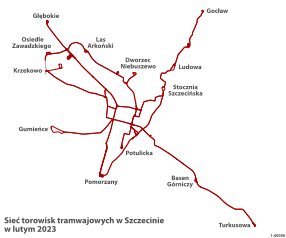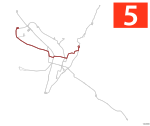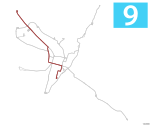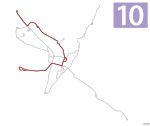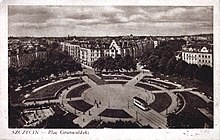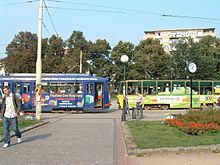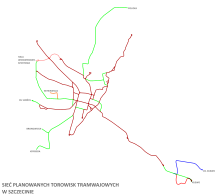Szczecin tram
| Szczecin tram | |
|---|---|
| Type 120NaS2 low-floor articulated multiple unit | |
| Basic information | |
| Country | Poland |
| city | Szczecin |
| opening | August 27, 1879 |
| operator | Tramwaje Szczecińskie sp zoo |
| Infrastructure | |
| Route length | 65.5 km |
| Gauge | 1435 mm ( standard gauge ) |
| Power system | 600 V DC overhead line |
| Stops | 101 |
| business | |
| Lines | 12 + 1 (tourist) |
| Cruising speed | 13.4 km / h |
| vehicles | 199 |
| statistics | |
| Passengers | 64.2 million per year (2010) |
| Mileage | 5.62 million km per year |
| Line network (as of 2020) | |
The Stettin tram (in Polish Tramwaje w Szczecinie ) is the eighth largest tram operator in Poland . The total network length is 64 kilometers, and a total of 98 stops are served. Lines 1 to 12 are currently operating in Szczecin .
The network is standard gauge and goes back to the horse tram of the Stettiner Straßen-Eisenbahn-Gesellschaft , opened in 1879 , which was electrified and expanded between 1897 and 1900.
The tram operator is the municipal transport company Tramwaje Szczecińskie Sp. Zoo , TS sp. zoo The urban streetcar traditionally forms the backbone of local public transport ( public transport ).
Current lines
history
Horse tram
On October 21, 1872, before the fortress walls of the city of Stettin were razed, the engineer Johannes Büssing received an order from the Berlin police to build a horse-drawn tram . Six years later, a contract was signed with the city of Szczecin to build a horse-drawn tram. The Stettiner Straßen-Eisenbahn-Gesellschaft was founded on March 25, 1879, and the tram lines were to be operated by this company. On August 23, 1879, the first horse-drawn railway line went into operation. It led from the Westend via Berliner Tor, Rossmarkt, Königstor to Elysium. Two months later, on October 16, 1879, the second line went into operation. It led from the Frauendorf via Ludowa, Königstor, Berliner Tor to Al. 3 maja. The route of the first line was used between the Berliner Tor and Grabower Strasse. The length of the network was approximately 11½ kilometers. 20 two-axle wagons from Würzburg served as vehicles , and the company also had 80 horses available. The first depot was at al. Wojska Polskiego, that is where the vehicles and horses were parked. On August 3, 1885, the first line built was divided into two lines, one line branch led from the main station to Elysium and the second from the main station to the Westend. Another line was opened on the same day. This led from Cap Cherie to the steamship bulwark. The line did not yet have a connection to the rest of the tram network; this could only be established in 1887.
Electrification and time up to World War II

On July 4, 1897, the first electric tram line went into operation. It led from the Westend to the Breite Straße. In 1898 the Szczecin Road Railway Company still owned 39 horse-drawn carriages and 198 horses. In the period that followed, the horse tram lines were converted to electrical operation by the Allgemeine Elektrizitäts-Gesellschaft . In 1900 the electrification of all tram lines was completed. Some sections of the route were expanded to double tracks. On October 1, 1904, the line from the Berliner Tor to the central cemetery was opened. In 1905 the lines were numbered and marked with different colors.
- Line 1: Westend (Łękno) - Lastadie (Łasztownia) (line color: yellow)
- Line 2: Berliner Tor (Brama Portowa) - Central Cemetery (Cmentarz Centralny) (line color: gray)
- Line 3: Nemitz (Niemierzyn) - Hauptbahnhof (line color: orange)
- Line 4: Pommerensdorf (Pomorzany) - Arndtplatz (pl.Szarych Szeregów) (line color: green)
- Line 5: Alleestr. (Wawrzyniaka) - Turnerstr. (Jagiellońska) - Unterwiek (Jana z Kolna) (line color: blue)
- Line 6: Hauptbahnhof - Zabelsdorf (Niebuszewo) (line color: white)
- Line 7: Frauendorf (Golęcino) - Bellevue (Potulicka) (line color: red)
In 1907 the Niemierzyn tram depot was opened. The purchase of new vehicles made another depot necessary; the Golęcin depot was put into operation in 1912. The existing tram lines were extended several times until the First World War . In 1912 another line, Line 8, was put into operation. It led from Schinkelplatz (pl. Kościuszki) to Grabower Straße. Because of the First World War, no changes were made to the tram network until 1923 ; from 1919, mail was transported in the tram. At the beginning of the First World War, the number of passengers rose as the tram was regularly used by soldiers. From 1920 to 1924 the number of passengers decreased again due to inflation . From 1923, line 4 led to the central cemetery, lines 2 and 8 were shut down due to a lack of vehicles. Line 2 was reactivated just one year later, as 20 new vehicles were delivered from Dessau . With the delivery of 42 new vehicles, operations on the remaining lines could be maintained. In 1924 the section between the main train station and the central cemetery was closed, and line 4 ended at the main train station. In 1926, construction work began on a tram connection to the airport, and in 1927 the extension to the airport was completed. Due to the desire to have a separate tram connection for numerous residential areas, the tram lines were extended several times in the following period. The average speed of the tram cars was 16 km / h. In 1934 lines 5 and 7 exchanged their line numbers. The length of the network was 50.3 kilometers in 1940, and 58.8 million people were transported on it. In the middle of the Second World War , operations had to be stopped on some lines, as these were no longer passable due to the attack by the Allies. On April 24, 1945, German authorities decided to give up the tram completely.
After the Second World War
After the Second World War, approximately 75% of the overhead contact line , 70% of the vehicles and 56% of the entire tram network were destroyed. With the purchase of new vehicles and the reconstruction of the tracks, operations could be resumed on August 12, 1945. For the time being, only lines 1, 3, 4 and 7 were operated. Line 6 could only be put back into operation in 1946, as the bridge over the railway systems at the station, which was destroyed in the Second World War, could not be put back into operation until mid-1946. The following lines were in operation in 1946:
- Line 1: Wojska Polskiego - Brama Portowa (Berliner Tor)
- Line 3: Las Arkoński (Eckerberger Wald) - Central Station
- Line 4: Matejki - pl. Kościuszki
- Line 6: Gocław (Gotzlow) - Lubeckiego
- Line 7: Hutnicza - Mickiewicza
By 1948, operations were restored on seven lines:
- Line 1: Zajezdnia Pogodno - Wojska Polskiego - Brama Portowa
- Line 2: Kołłątaja - Niebuszewo station (Zabelsdorf)
- Line 3: Pomorzany (zoo) - Las Arkoński
- Line 4: Powstanców Wlkp. - Central Station
- Line 5: Lubeckiego - Ku Słoścu
- Line 6: Gocław - Lubeckiego
- Line 7: Żołnierska - Jana z Kolna (Unterwiek)
Line 8 was subsequently reopened. Since the Lubeckiego bridge could be reopened in 1950, the extension of line 5 to Goclaw could be put back into operation. In the same year the route of tram line 6 was changed, it ran from Nocznickiego to Potulicka. A ring tram line could be established through line 6 at the beginning of 1951. In 1953 a new line was put into operation. It was designated as line 9 and drove from Żołnierska to Wawrzyniaka. Another network expansion followed a year later, and some lines could be extended to a new end point in Krzekowo. In 1953 the tram received 16 LOWA railcars , which were built in 1951 for the Warsaw tram . In addition, 17 older railcars came from Warsaw and Breslau . In 1955 further extensions of tram lines 1 and 8 followed. After the operation on line 9 was no longer profitable, it was discontinued in 1957. After 1961 a new line 9 was built from Zajezdnia Pogodno to Potulicka. Another new 4N car was delivered in 1962. In the period that followed, used vehicles were taken over from Warsaw and Wroclaw. In 1964 the following lines were in operation:
- Line 1: Głębokie - Wojska Polskiego - Brama Portowa - Potulicka
- Line 2: Niebuszewo station - Wyzwolenia - Brama Portowa - Wyszyńskiego - Gdańska - Kaszubski bases
- Line 3: Pomorzany - Las Arkoński
- Line 4: Pomorzany - pl. Kościuszki - Piłsudskiego - Brama Portowa - Central Station
- Line 5: Krzekowo - Mickiewicza - Jagiellońska - Obronców Stalingradu - Matejki - Stocznia Szczecińska - Stocznia Remontowa
- Line 6: Gocław - Dworcowa
- Line 7: Krzekowo - Mickiewicza - Jagiellońska - Obronców Stalingradu - Wyszaka - Stocznia Szczecińska
- Line 8: Gumieńce - Brama Portowa - Gdańska - Kaszubski Bases
- Line 9: Zajezdnia Pogodno - Wojska Polskiego - Potulicka
On April 26, 1965, the routes of tram lines 1, 7 and 9 were changed. On October 27, 1967, a new line 10 was built, this runs from Stocznia Remontowa to Wawrzyniaka. On December 15, 1974, tram line 11 was opened, it led to Pomorzany after Ludowa. It was only in 1975, all tram railcars in could unidirectional operation run after the last final stop with a turning loop was equipped. On July 4, 1983, the extension of line 2 to Basen Górniczy was put into operation. Another tram line was opened in 1985; it was called Line 12 and runs from Pomorzany to Glebokie. In 1991 tram line 1 was shut down due to declining passenger numbers, in 1992 line 10 was shut down in 1995, tram line 3 was shut down, and in 1996 it was reopened on a shortened section. On January 2, 1996, line 1 was put back into operation with a modified route. In January 1996 it was decided to take over old vehicles from Düsseldorf and to renovate them in Stettin. In 2006, a contract was signed with the Berliner Verkehrsbetriebe (BVG) to take over 21 Tatra vehicles of the type KT4Dt. In the period that followed, the BVG gave 12 more vehicles of this type to the Szczecin tram.
Planned network expansions
After extensive expansion plans existed in the 1970s, the first stage of a route extension from the terminal Basen Górniczy of lines 2, 7 and 8 was built from 2012 to 2015. Under the name Szczeciński Szybki Tramwaj (SST, in German Stettiner Schnellstraßenbahn), the route was extended in 2015 as a completely crossing-free express tram from Basen Górniczy to the intermediate loop Turkusowa in Szczecin-Zdroje. This is the decisive step towards connecting the extensive housing estates on the east bank of the Oder. At the moment, however, the vast majority of the densely populated residential areas in Zdroje are still not reached directly by tram; several express bus lines run parallel to the tram directly into the city center. In a second stage, the route is therefore to be extended to Kijewo by 2020 and would then be 6.4 kilometers long. In 2012, investment costs of 400 million złoty (about 94 million euros) were estimated for this.
Further planned new lines with mostly existing clearances in the median of main roads, mostly created in the last few years, are
- Niemcewicza (lines 2 + 12) or Krasińskiego (lines 3 + 10) - Kormoranów - Łączna / Warszewo in the north of the city, where large new building areas are being built
- Dąbrowskiego (lines 4, 11 + 12) - Cukrowa in the immediate vicinity of the Gumieńce border station and a university campus
- from Turzyn (lines 7 + 9) along roads 26 Kwietnia and Taczaka to Krzekowo (lines 4, 5 + 7) and from there on:
- Krzekowo (lines 4, 5 + 7) - Szafera - Spacerowa (lines 1 + 9) - Las Arkoński (lines 3 + 10). Since the Pogodno depot (Zajezdnia Pogodno) is located near the Spacerowa stop on lines 1 and 9, at least the Spacerowa - Las Arkoński connection will be needed in the next few years to rehabilitate the lines 1 and 9 in aleja Wojska Polskiego to be able to and at the same time not completely disconnect the most important depot.
- In the short term, the route to Gumieńce (lines 8 + 10) is to be extended to the level of the existing Hrubieszowska bus stop at the STER shopping center. The city has put funds in the budget for preparations. To this end, the northern part of the Gumieńce block bypass from the Ku Słońcu stop to the west in the median of the street of the same name is to be expanded to two tracks.
Depots
Golęcin
The Golęcin Depot was built in 1912. The depot was expanded in 1926, 1979 and 1992. The depot has had type 105N2K / S vehicles since May 2001, and Tatra T6A2 D vehicles since 2008. Today, the depot is responsible for lines 3, 5, 6, 11 and 12.
Pogodno
The depot was built in 1934 and is the largest of the Szczecin trams. In 1981 the depot was modernized. Vehicles of the types 105N2K / S and Tatra KT4 DTM are stationed in the depot today. In addition, 22 Tatra T6A2 D vehicles. Lines 1, 2, 3, 4, 5, 7, 8, 9, 10 and 12 are served from the Pogodono depot.
Disused depots
- Niemierzyn Depot (closed on October 1, 2004; today the Museum of Technology and Transport is located there)
- Depot Krzysztofa Kolumba (today warehouse)
- Piotra Skargi depot
- Depot Dębogórska (Żelechowa)
- Depot Dubois (Grabowo)
vehicles
Coloring
Until 1945, the trams were mostly painted cream. In the 1950s, a new color scheme was created, the car body was painted red below the windows, the doors and the roof molding cream-colored. From 1999 to 2005 the lower car body was blue or purple. The sides were painted white and the roof molding purple. Since 2005 the side walls have been painted purple instead of white. The cars have been painted white since 2007. The rear front is given a white, green and blue color.
Vehicle tables
As of May 11, 2020
| image | Type | in use since | description |
|
number |
|---|---|---|---|---|---|
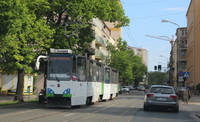
|
Konstal 105Ng / S | 2000 | The vehicles were created in 2000 and 2001 from conversions of the vehicle type 105Na in the Szczecin depots. There are a total of twelve vehicles of this type in Szczecin. | 12 | |

|
Konstal 105N2k / 2000 / S | 2001 | The Konstal 105N2k / 2000 / S trains were built in 2001. At that time they were the newest trams on the Stettin tram; the interior consists mainly of plastic. | 14th | |
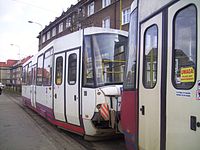
|
Konstal 105N2k / 2000 / S (sidecar) | 2007 | 6th | ||

|
Tatra KT4 German | 2006 | The Tatra KT4Dt vehicles produced from 1982 to 1984 have been sold piece by piece by the Berliner Verkehrsbetriebe (BVG) to the tram company in Szczecin since 2006 . More cars are to follow by 2014, and cars are currently always being bought that have been parked in Berlin due to the deadline. | 73 | |

|
Tatra T6A2 D | 2008 | The Tatra T6A2 vehicles produced from 1988 to 1991 were completely retired and parked in Berlin in 2007 , so that 54 vehicles from the Berlin tram were handed over to the Szczecin tram. The Szczecin car 1212 was scrapped in 2012. | 48 | |

|
Moderus Alfa HF09 | 2008 | These vehicles are modernized type 105Na trams. The renovation was carried out at Modertrans Poznań. Side cars of this type are conversions of the type 105Na railcars. The driver's cab was removed during the conversion. | 2 | |

|
Moderus Alfa HF10AC | 2008 | These vehicles are modernized type 105Na trams. The renovation was carried out at Modertrans Poznań. Side cars of this type are conversions of the type 105Na railcars. The driver's cab was removed during the conversion. | 12 | |
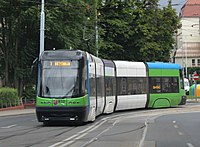
|
Pesa 120NaS | 2011 | These vehicles are the first low-floor vehicles on the Szczecin tram. They were built in 2010 and have been in use as planned since 2011. |
|
6th |

|
Pesa 120NaS2 | 2011 |
|
22nd | |

|
Moderus beta | 2014/2018 |
|
4th | |
| Total number of vehicles | 199 | ||||
| Share of low-floor vehicles | 16% | ||||
Planned vehicle purchases
In 2011 and 2012, four Konstal 105N railcars were converted by Modertrans Poznań into Moderus Alfa. Both the interior and exterior design were completely redesigned. 18 more 105N railcars are still to be converted into Moderus Alfa.
Since mid-2012, further KT4Dt wagons have also been purchased from Berlin with the deadline expired.
In January 2012, the procurement of 22 low-floor multiple units was also put out to tender. Offers were submitted by Škoda , Solaris , PESA and CAF .
The city of Szczecin has chosen PESA as its preferred provider. It should mover carriage type PESA Swing to be procured. They are 31 meters long and 2.4 meters wide. They offer space for 200 passengers, 40 of which are seated. The unit price is 6.82 million zlotys . The delivery is to take place between October 2013 and March 2014. They are intended to be used on the planned new route in the east of the city.
Web links
literature
- Stettiner Straßen-Eisenbahn-Gesellschaft: Tram in Szczecin 1928 - city map with tram lines . GVE-Verlag Berlin, restored version of the original map, reprint 2019, ISBN 978-3-89218-728-8 .
- Robert Schwandl: Tram Atlas Poland Poland . 1st edition. Robert Schwandl Verlag, Berlin 2017, ISBN 978-3-936573-50-3 , pp. 90–95 , chapter Szczecin (German, English).
Individual evidence
- ↑ line ZDiTM. zditm.szczecin.pl, accessed on April 16, 2016 .
- ↑ a b c d e f History of the Stettin tram
- ↑ a b c d e f line chronicle on berlin.bahninfo.de
- ↑ a b c Remigiusz Grochowiak: 120 lat komunikacji miejskiej w Szczecinie . EMI-PRESS 1999.
- ↑ Volker Vondran: The LOWA tram cars . In: Verkehrsgeschichtliche Blätter . Volume 6, 1981, pp. 147-156 .
- ^ A b Stefan von Mach: Modernization of the trams in Poland . In: City traffic . tape 57 , (July-August), 2012, ISSN 0038-9013 , p. 40 .
- ↑ Gumience24.pl: Gumience 24 - Pętla tramwajowa przy CH Ster na Gumieńcach. In: Gumience24.pl. 2015, accessed September 21, 2016 (Polish).
- ↑ a b page about the whereabouts of former Berlin trams on berlin-straba.de

